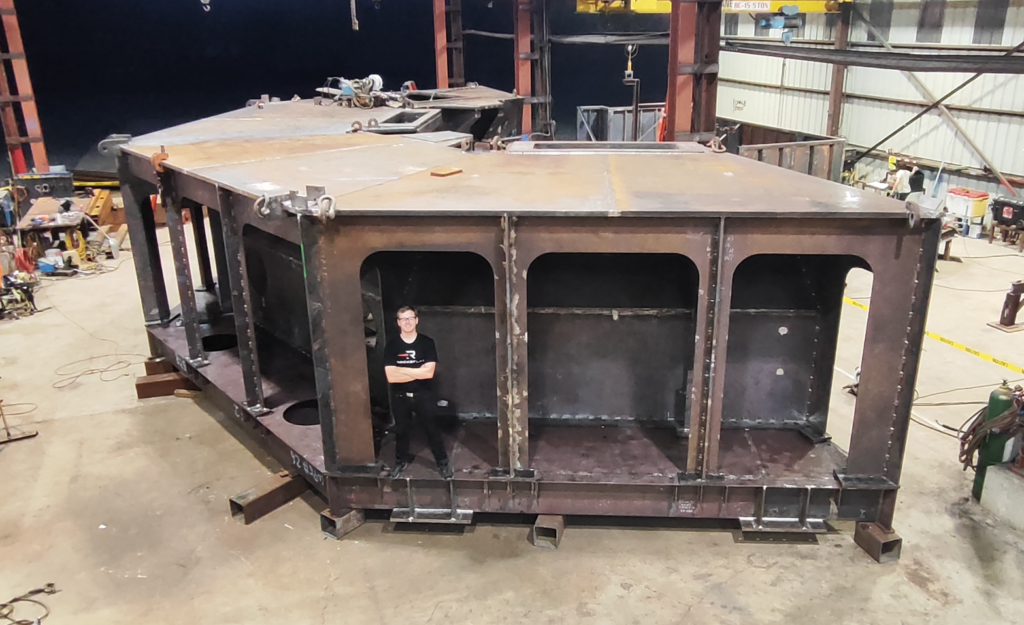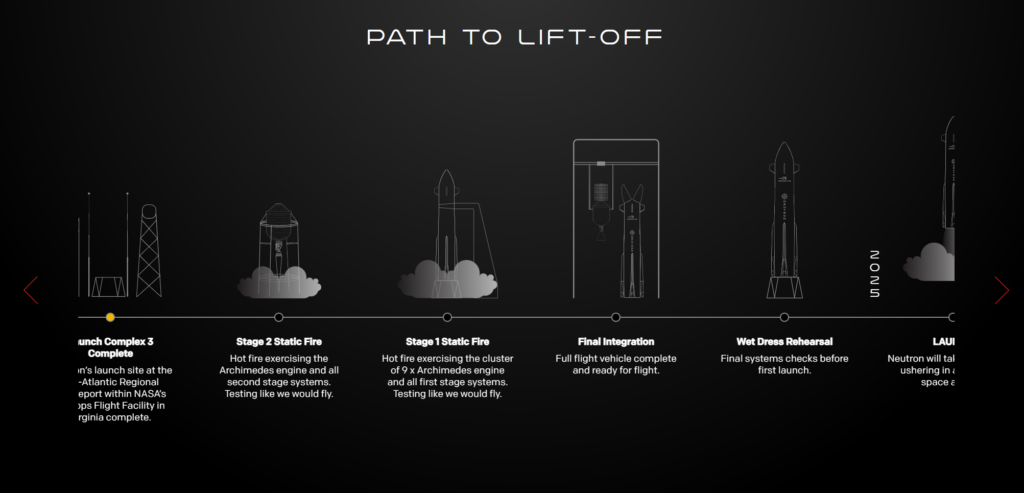Rocket Lab’s new launch vehicle Neutron is already starting to secure some significant launch contracts both with the government and different commercial companies. This includes a new announcement from the company only days ago outlining a multi-launch agreement set to occur in 2026.
At the same time, we are continuing to get the occasional update on actual launch progress including recent work on the medium lift launch vehicle’s new 165-ton launch mount.
Progress & Contracts

With Neutron set to be much more powerful than Electron and feature unique capabilities like the booster landing back at the launch site, Rocket Lab needed a new launch pad. While work has been progressing on Neutron’s main tanks and Archimedes engines, we’ve seen constant work on the stage 0 infrastructure as well.
Yesterday Rocket Lab tweeted saying, “We’re going heavy metal… er, steel with our 165-tonne Neutron launch mount for Launch Complex 3. This structure is completing fabrication and will be ready for installation at the launch site in the coming weeks before focus shifts to launch pad commissioning for Neutron’s first launch. Rocket Lab engineer for scale. Looking at the included images its obvious based on the size and strength of this launch mount they’re getting ready for a powerful rocket.
This joins a host of other projects related to the pad including the installation of a water tower, massive propellant tanks, concrete being poured, etc. The company is still targeting a maiden flight in 2025 which means these pad systems need to come online relatively soon in order to stay on schedule. Especially when you consider that some of the pre launch mission milestones will include wet dress rehearsals and static fires expected to be done at Launch Complex 3.
In addition to physical progress, Rocket Lab announced a new launch contract for the vehicle. Specifically, in a statement the company said, “Rocket Lab today announced it has signed a multi-launch agreement with a confidential commercial satellite constellation operator for its new medium-lift rocket Neutron. Under the contract, Rocket Lab will launch two dedicated missions on Neutron starting from mid-2026. The missions will launch from Rocket Lab Launch Complex 3 on Wallops Island, Virginia. The launch service agreement for these missions signifies the beginning of a productive collaboration that could see Neutron deploy the entire constellation” they said.
In regard to this, Rocket Lab founder and CEO, Peter Beck, said: “Constellation companies and government satellite operators are desperate for a break in the launch monopoly. They need a reliable rocket from a trusted provider, and one that’s reusable to keep launch costs down and make space more frequently accessible – and Neutron is strongly positioned to be that rocket that provides choice and value to the industry. We’ve changed the game before with Electron for dedicated small launch and HASTE for hypersonic technology tests, and we’re looking forward to Neutron doing the same for constellation operators and national security” he said.
This contract fits in with Neutron’s future goal. Since the start Rocket Lab has expressed that the medium-lift partially reusable Neutron vehicle will provide both commercial and government customers an alternative reliable launch service capable of deploying 13,000 kg to low Earth orbit. They have made it clear that Neutron is tailored to deploy constellations and national security missions as well as science and exploration payloads.
As far as what this launch market has to offer, the company is confident there is substantial demand. In another statement they said, “Neutron is strongly positioned to capitalize on the medium-lift launch requirements for future commercial and government missions, with more than 10,000 satellites projected to need launch services by 2030 in a total addressable market valued at approximately ~$10 billion*.”
“Neutron’s expected debut launch in 2025 also puts the launch vehicle in a strong position to on-ramp onto the U.S. Government’s National Security Space Launch (NSSL) Lane 1 program, an indefinite delivery indefinite quantity (IDIQ) contract valued at $5.6 billion over a five-year period. RFPs for the program opened on October 30th 2024 with approved new launch vehicles to be on-ramped to the program in Spring 2025. The NSSL Lane 1 program is designed by the U.S. Space Force to build up a reliable domestic industrial base of commercial launch vehicles to serve national security missions. If on-ramped in 2025, Rocket Lab would be only the fourth launch provider accepted into the program. Neutron is also eligible to compete for missions under the United States Space Force’s OSP-4 program, a separate $986m IDIQ contract” they said.
Based on these comments, its clear that getting Neutron up and running in a timely manner would facilitate some significant contracts. That being said, there still is quite a bit of work left before Neutron is ready and on the launch pad.
Neutron’s Timeline

While Neutron and Rocket Lab are making solid progress, based on their own estimates they are slightly behind. Looking at the company’s website, they provide a timeline of some of the major Neutron developments leading up to launch, including a general date by which they hope to complete them.
Back in 2023 we saw some of these initial milestones being completed such as the Stage 2 build, structural and cryogenic testing, the Archimedes engine build, and testing of all the avionics and communications devices with critical onboard software and GNC algorithms.
Moving to this year, Rocket Lab had some ambitious goals. The timeline highlights that they had hoped to complete practically every pre launch test with the exception of the launch itself by the end of this year. That includes the static fire of both the first and second stage, stacking the vehicle, and even a full wet dress rehearsal. With it already being the middle of November, obviously a lot of these milestones will be pushed to next year. Realistically, we could expect a Neutron launch around late 2025.
On the bright side, they did manage to complete or start work on some of the most time consuming pre launch activities. Archimedes for example, Neutron’s new engine, has already been static fired and is making good progress.
You then have three major items currently designated as under progress, the Flight Mechanisms Test Program, Stage 1 build, and construction of Launch Complex 3. The Flight Mechanisms test involves testing of critical flight mechanisms including separation systems, fairing actuation, control surfaces and actuators. The stage 1 build and the launch site construction should be the two milestones that take the longest. Once complete, assuming Archimedes engines continue to be produced at a reasonable speed, integration onto the vehicle and eventual static fires don’t seem far away.
Each Neutron will require 10 Archimedes engines, 9 on the first stage and 1 vacuum optimized engine on the upper stage. Last month Peter Beck shared an image of an Archimedes engine being shipped out with the caption, keeping them shipping. Importantly, this is believed to be the fourth Archimedes engine that’s completed production. That leaves at least 5 more depending on which engines are qualified for flight and make it to vehicle integration. Fortunately that process should speed up as they get more experience building and testing the engines.
Rocket Lab highlights that each engine is capable of producing up to 165,000 (733 kilonewtons) pounds of thrust, and that Archimedes operates at lower stress levels than other rocket engines to enable rapid and reliable reusability. The combined thrust of nine Archimedes engines for Neutron’s first stage is designed to reach 1,450,000 lbf total. In terms of fuel, Archimedes uses a cryogenic propellant mix of liquid oxygen and LNG to enable higher reusability and performance.
The goal for the company is to both improve the design and speed up the general engine manufacturing over time. In support of this, many of its critical components are 3D printed including Archimedes’ turbo pump housings, pre-burner and main chamber components, valve housings, and engine structural components.
Also, when talking about Archimedes and Neutron’s timeline as a whole Peter Beck said, “What we’ve taken to the test stand is very close to a flight-like engine, and with all of our production infrastructure stood up alongside the engine’s development, we’re in a prime position to be able to make quick iterations to Archimedes for a rapid development and qualification campaign. We took the time to not only bring a mature design to the stand that has been thoroughly tested at the component level, but to also stand up the experienced team, manufacturing line, and test facilities required to support the long-term production of Archimedes.”
He went on to say, “This approach has ultimately pushed the first flight to mid-2025 at the earliest, but it’s an approach we believe will deliver the frequent flight rates the market needs quickly after flight one. Designing a brand-new rocket engine to meet the market demand for frequent and reliable launch is complex feat, but it’s something we’ve successfully done before, having launched more than 470 Rutherford engines to space. We look forward to repeating this success with Archimedes” he said.
Based on current progress it looks like most pre launch milestones are somewhat in sync, meaning the completion of the pad will be followed soon after with hardware starting to arrive and pad testing then being completed. Something to look forward to as they keep pushing toward a maiden flight.
Conclusion
Rocket Lab is not far from completing Launch Complex 3 as they work on the massive Neutron launch mount. At the same time they are securing even more launch contracts for the future vehicle, set to fly next year. Based on the current schedule and progress, a launch toward the end of 2025 seems like a realistic date the company could reach.
